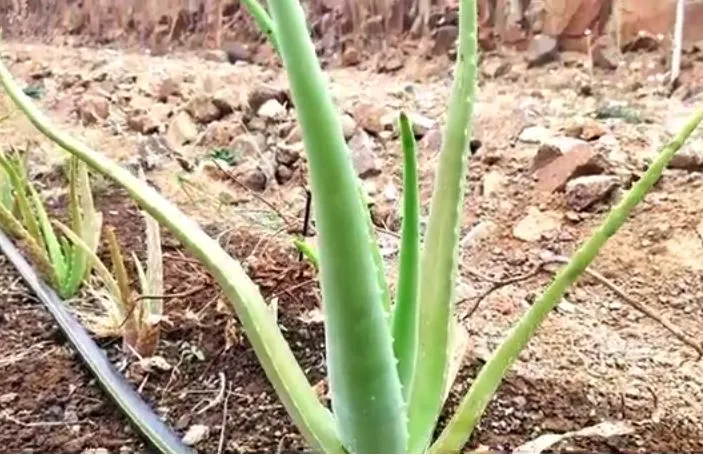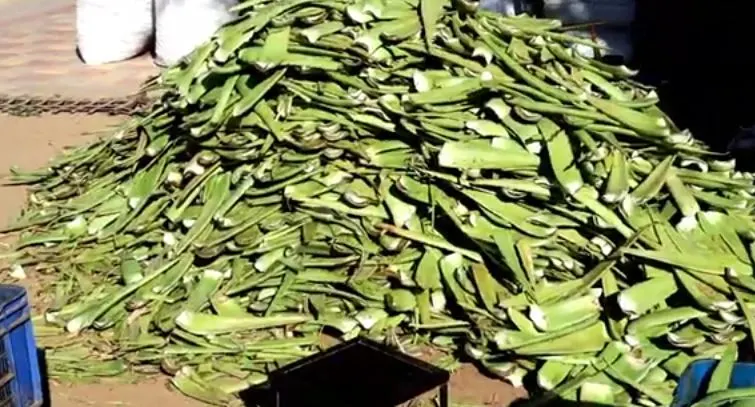Aloe Vera Farming Profit Per Acre: Detailed Plan to Earn 9 Lacs
Aloe Vera farming is gaining traction as a profitable agricultural venture, driven by the plant’s versatile uses in cosmetics, pharmaceuticals, and the health food industry. This article explores the financial aspects of Aloe Vera cultivation, detailing initial setup costs, annual expenses, revenue projections, and profitability per acre.
Aloe Vera, known for its medicinal properties and high nutritional value, has become a sought-after crop in agriculture. Its gel-filled leaves are utilized in skincare products, beverages, and supplements, making Aloe Vera farming a promising enterprise for farmers seeking diversification and profitability.
Initial Setup and Investment | Aloe Vera Farming Profit Per Acre
-
Land Preparation and Planting Material
- Land Preparation Costs: Preparing one acre of land for Aloe Vera cultivation typically costs around Rs 15,000, inclusive of plowing, ridging, and other preparatory activities.
- Planting Material: Aloe Vera is propagated through suckers. Approximately 10,000 suckers are required per acre, costing Rs 0.50 each, totaling Rs 5,000.
-
Manure and Fertilizers
- Farmyard Manure (FYM): Aloe Vera thrives with organic enrichment. Annual application of 5 tonnes of FYM per acre is recommended, costing Rs 2,000.
- Chemical Fertilizers: Essential nutrients like nitrogen, potassium, and phosphorus are supplied through fertilizers, totaling approximately Rs 4,500 per year.
-
Irrigation
- Initial Setup: Installing drip irrigation systems, crucial for efficient water management, costs about Rs 10,000 per acre.
- Annual Maintenance: Ongoing maintenance and electricity for irrigation amount to Rs 5,000 per year.
-
Labor
- Labor Costs: Various farming operations including planting, weeding, fertilizing, irrigation, and harvesting require labor. Annual labor costs are estimated at Rs 60,000 per acre

Project Cost And Revenue | Aloe Vera Farming Profit Per Acre
Key Points to Ensure Success
- Quality Planting Material: Using healthy suckers ensures robust growth and higher yields.
- Proper Irrigation: Efficient water management through drip irrigation systems is essential for optimal Aloe Vera growth.
- Soil Health: Regular application of organic manure and balanced chemical fertilizers maintains soil fertility.
- Timely Harvesting: Harvesting Aloe Vera leaves at the right maturity stage preserves their quality and market value.
- Market Access: Establishing reliable market connections ensures consistent sales and profitability.
In conclusion, Aloe Vera farming offers a lucrative opportunity for farmers seeking profitability and diversification. By understanding the initial investment requirements, annual operational costs, revenue potential, and implementing effective farming practices, farmers can capitalize on the growing demand for Aloe Vera products in various industries.
Additional Tips (Optional)
- Sustainable Farming Practices: Implementing eco-friendly practices enhances long-term viability.
- Government Support: Exploring government subsidies or schemes can aid in initial setup and operational costs.
- Future Outlook: With increasing consumer awareness about health and wellness products, the demand for Aloe Vera is expected to grow, presenting favorable market conditions for farmers.
By embracing Aloe Vera farming with diligence and strategic planning, farmers can secure a profitable future in agriculture while contributing to the growing health and wellness sector.
FAQs About Aloe Vera Farming | Aloe Vera Farming Profit Per Acre
1. What is Aloe Vera farming?
Aloe Vera farming involves cultivating Aloe Vera plants primarily for their medicinal and commercial uses. The gel extracted from its leaves is widely used in cosmetics, pharmaceuticals, and health food products due to its therapeutic properties.
2. Is Aloe Vera farming profitable?
Yes, Aloe Vera farming can be profitable. With proper management and market access, farmers can generate significant income from the sale of Aloe Vera leaves, which are in high demand for various industries.
3. What are the initial costs involved in Aloe Vera farming?
The initial costs include land preparation, planting materials (suckers), fertilizers (organic and chemical), irrigation setup, and labor. These costs vary but are generally manageable compared to potential returns.
4. How much land is required for Aloe Vera farming?
Aloe Vera can be grown in various climates and soil types. Typically, one acre of land can support Aloe Vera cultivation, depending on the density of planting and farming practices employed.
5. What are the ideal growing conditions for Aloe Vera?
Aloe Vera thrives in well-drained sandy or loamy soils with good sunlight exposure. It requires minimal water and can tolerate dry conditions, making it suitable for semi-arid regions.
6. How long does it take for Aloe Vera plants to mature?
Aloe Vera plants generally reach maturity in about 2-3 years. They can be harvested periodically for their leaves once they reach a suitable size, typically 2-3 years after planting.
7. How often do Aloe Vera plants need to be watered?
Aloe Vera plants are drought-resistant but require occasional watering during dry periods. In most cases, watering once every 2-3 weeks is sufficient, depending on local climate conditions.
8. What pests and diseases affect Aloe Vera plants?
Aloe Vera is relatively resistant to pests and diseases. However, common issues include root rot due to overwatering, aphids, and mealybugs. Regular monitoring and proper cultural practices help prevent and manage these problems.
9. How are Aloe Vera leaves harvested and processed?
Aloe Vera leaves are harvested by cutting them close to the base of the plant. After harvesting, the leaves are processed to extract the gel, which is then used in various products such as gels, juices, and skincare items.
10. What markets exist for Aloe Vera products?
Aloe Vera products have a diverse market including cosmetics, pharmaceuticals, health supplements, and beverages. There is also growing consumer interest in natural and organic products, further boosting demand.
You Can read this too
